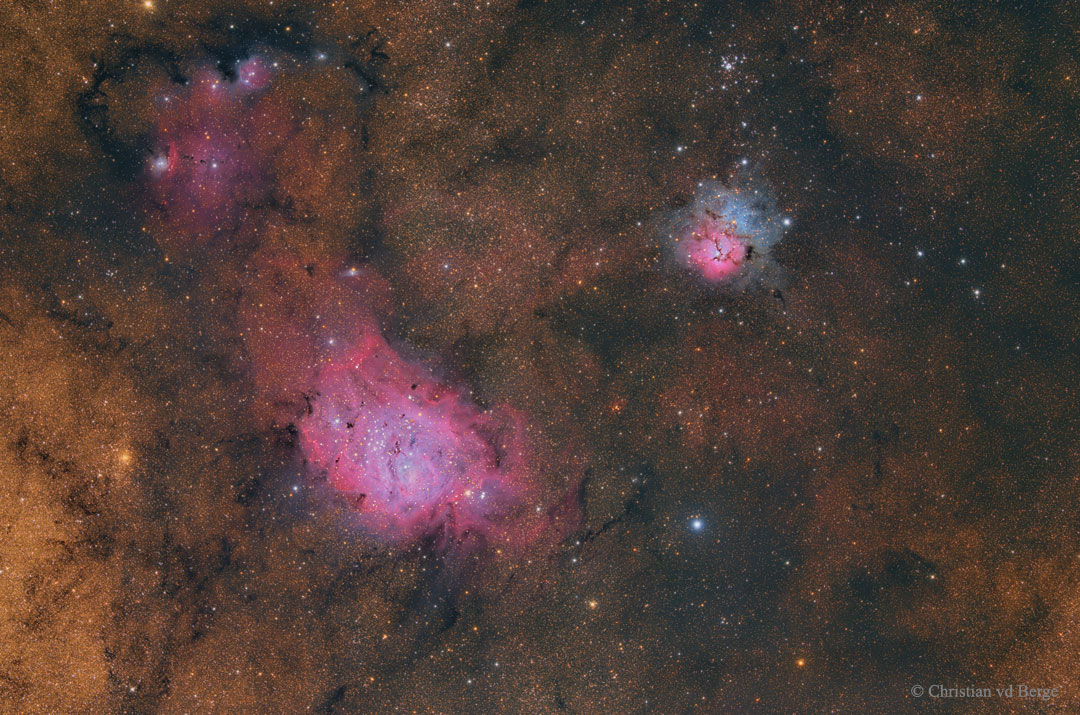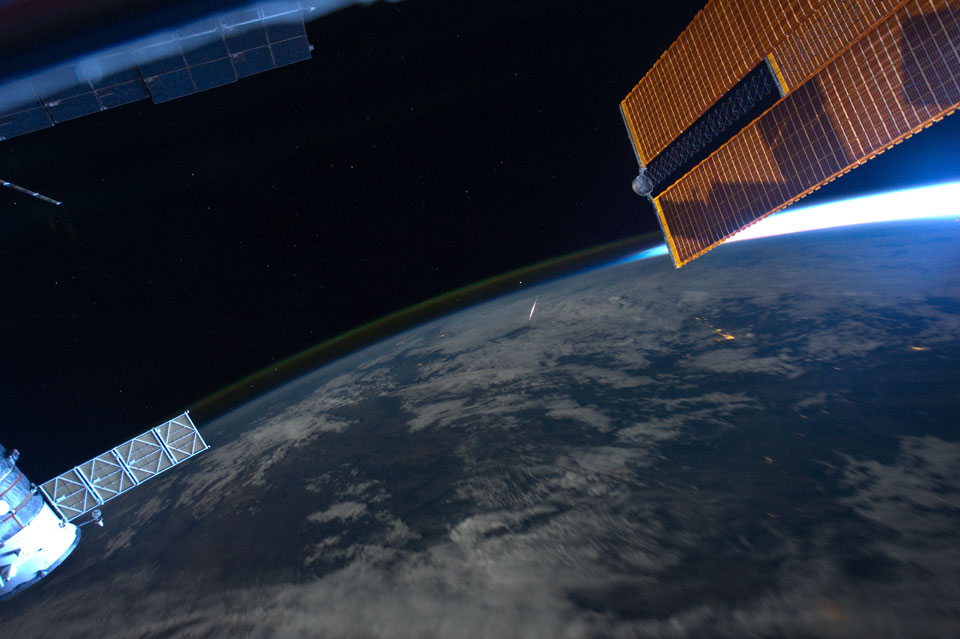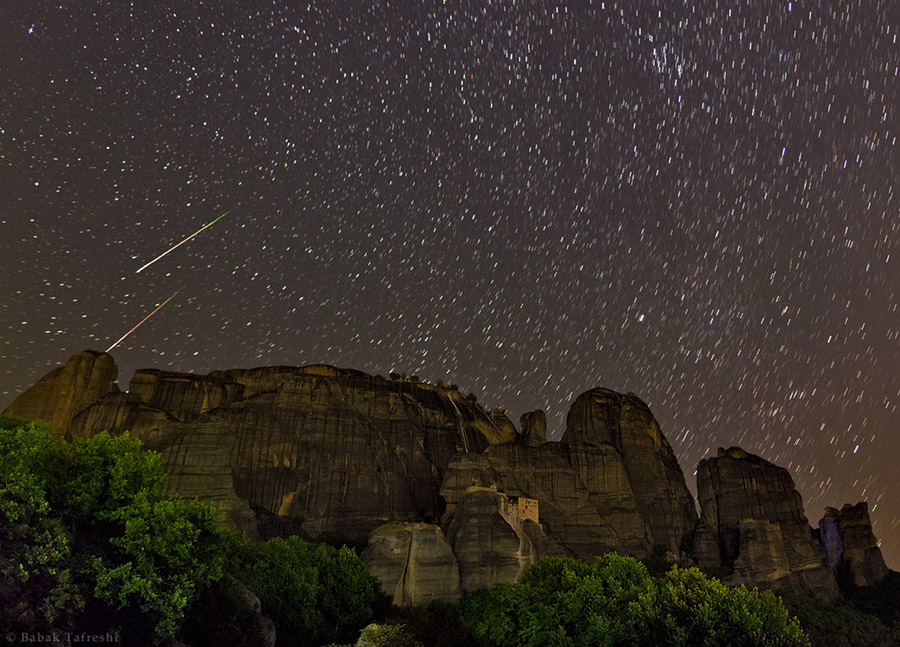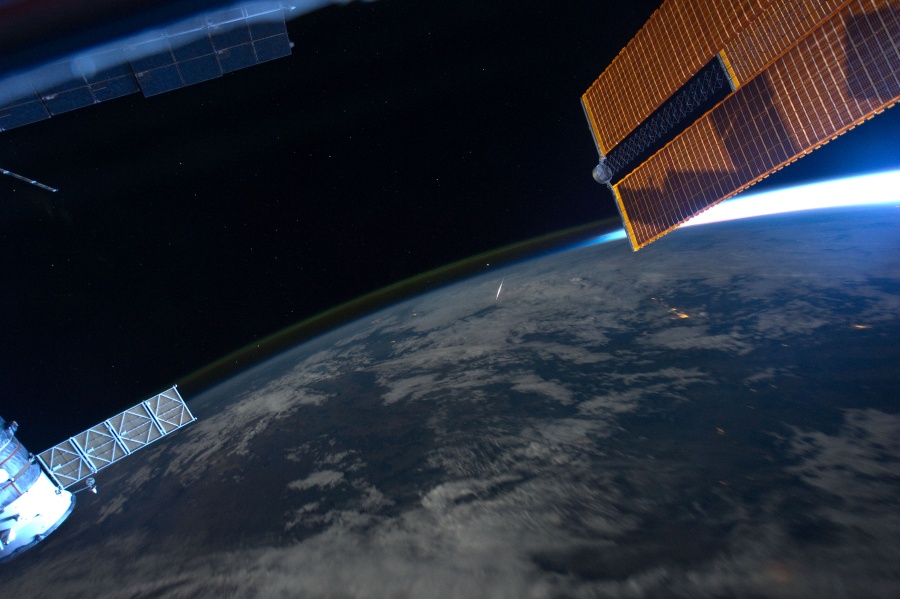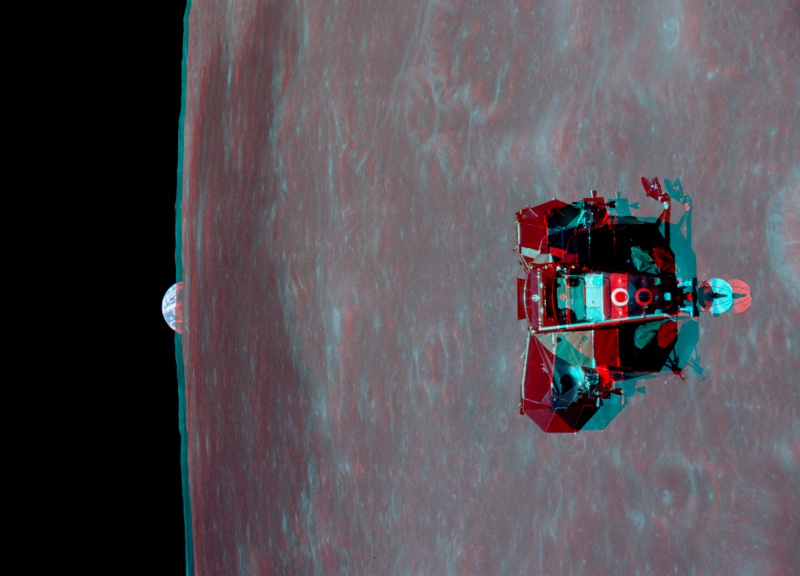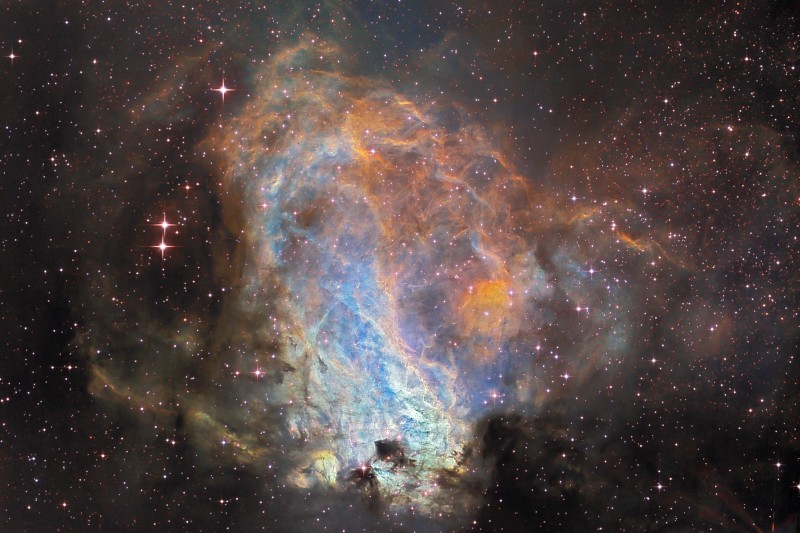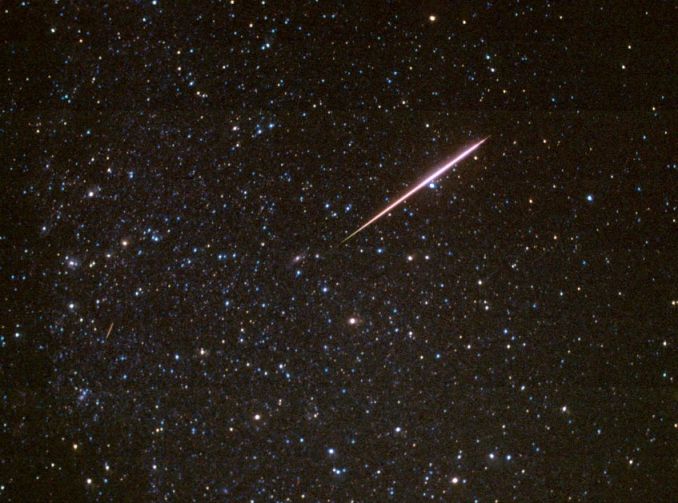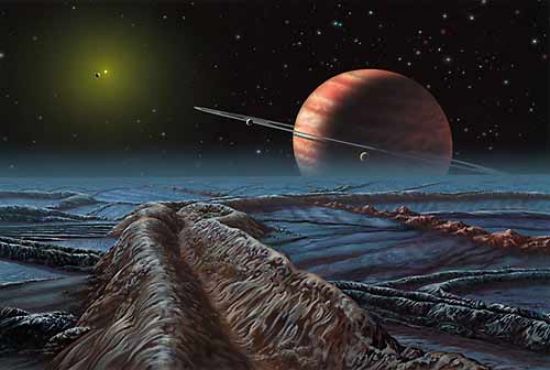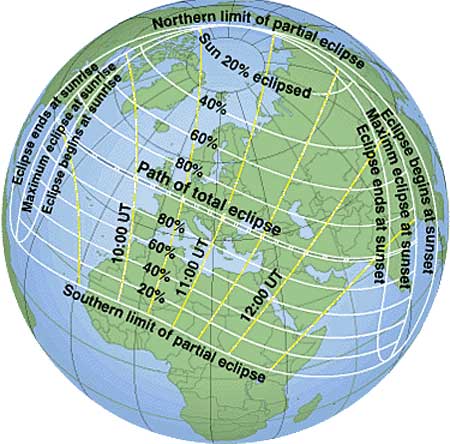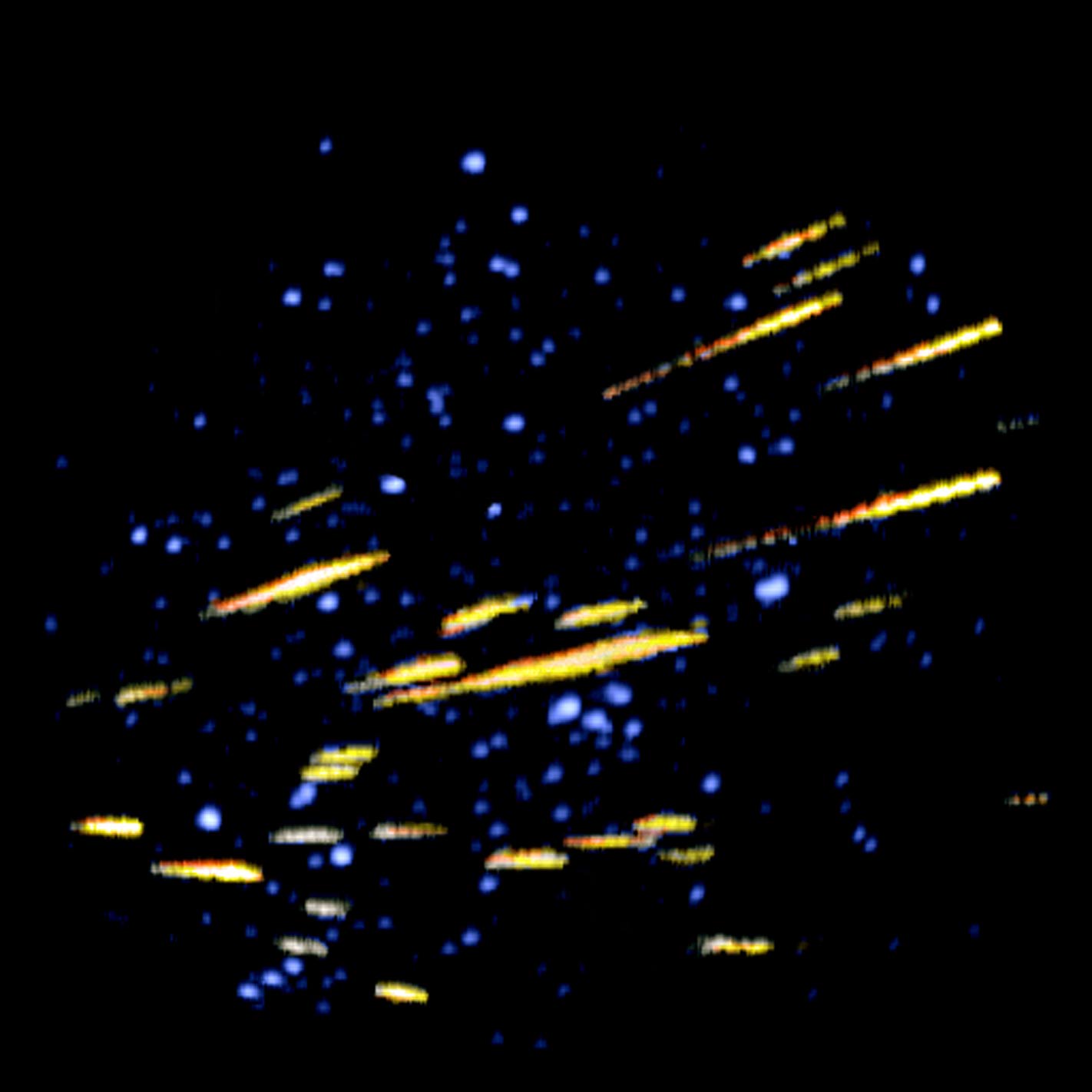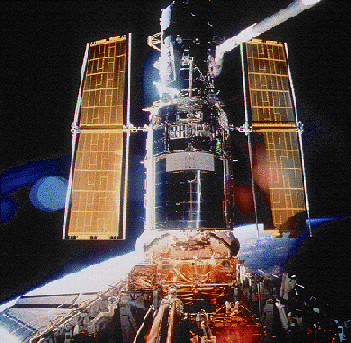| << Previous | Index | Next >> |
2015 These three bright nebulae are often featured in telescopic tours of the constellation Sagittarius and the crowded starfields of the central Milky Way. In fact, 18th century cosmic tourist Charles Messier cataloged two of them; M8, the large nebula left of center, and colorful M20 on the right. The third, NGC 6559, is above M8, separated from the larger nebula by a dark dust lane. All three are stellar nurseries about five thousand light-years or so distant. The expansive M8, over a hundred light-years across, is also known as the Lagoon Nebula. M20's popular moniker is the Trifid. Glowing hydrogen gas creates the dominant red color of the emission nebulae, with contrasting blue hues, most striking in the Trifid, due to dust reflected starlight. The colorful skyscape recorded with telescope and digital camera also includes one of Messier's open star clusters, M21, just above the Trifid.
2014 Denizens of planet Earth typically watch meteor showers by looking up. But this remarkable view, captured on August 13, 2011 by astronaut Ron Garan, caught a Perseid meteor by looking down. From Garan's perspective onboard the International Space Station orbiting at an altitude of about 380 kilometers, the Perseid meteors streak below, swept up dust left from comet Swift-Tuttle heated to incandescence. The glowing comet dust grains are traveling at about 60 kilometers per second through the denser atmosphere around 100 kilometers above Earth's surface. In this case, the foreshortened meteor flash is right of frame center, below the curving limb of the Earth and a layer of greenish airglow, just below bright star Arcturus. Want to look up at a meteor shower? You're in luck, as the 2014 Perseids meteor shower peaks this week. Unfortunately, the fainter meteors in this year's shower will be hard to see in a relatively bright sky lit by the glow of a nearly full Moon.
2013 The two bright meteors flashing through this night skyscape from August 7 are part of the ongoing Perseid meteor shower. In the direction indicated by both colorful streaks, the shower's radiant in the eponymous constellation Perseus is at the upper right. North star Polaris, near the center of all the short, arcing star trails is at the upper left. But also named for its pose against the sky, the monastery built on the daunting sandstone cliffs in the foreground is part of Meteora. A World Heritage site, Meteora is a historic complex of lofty monasteries located near Kalabaka in central Greece.
2012 Denizens of planet Earth watched last year's Perseid meteor shower by looking up into the bright moonlit night sky. But this remarkable view captured on August 13, 2011 by astronaut Ron Garan looks down on a Perseid meteor. From Garan's perspective onboard the International Space Station orbiting at an altitude of about 380 kilometers, the Perseid meteors streak below, swept up dust left from comet Swift-Tuttle heated to incandescence. The glowing comet dust grains are traveling at about 60 kilometers per second through the denser atmosphere around 100 kilometers above Earth's surface. In this case, the foreshortened meteor flash is right of frame center, below the curving limb of the Earth and a layer of greenish airglow, just below bright star Arcturus. Want to look up at this year's Perseid meteor shower? You're in luck. This weekend the shower should be near its peak, with less interference from a waning crescent Moon rising a few hours before the Sun.
2011
[imghover6=http://apod.nasa.gov/apod/image/1108/st ... do_900.jpg]http://apod.nasa.gov/apod/image/1108/st ... ed_900.jpg[/imghover6]Image Credit: Copyright: Juan Carlos Casado (TWAN)
2010 Why do some sand dunes on Titan appear backwards? Central Titan, it turns out, is covered by sand, some of which appears strange. Images from the Cassini spacecraft currently orbiting Saturn have uncovered long rows of huge sand dunes near Titan's equator that rise as high as 300 meters. Shadows indicate that most dune shapes are created by wind blowing from the west. The problem is, the typical wind at Titan's equator blows from the east. One recent hypothesis that might solve this grainy conundrum posits that the only winds strong enough to move sand and create dunes occur during rare equinoxes and blow strongly from the west. The above images show a radar swath of Titan's equatorial sand dunes at the top, while similar sand dunes that formed in Namibia on Earth at the bottom. Why central Titan is even covered by so much sand is still being investigated.
2009
Click to play embedded YouTube video.
Credit & Copyright: Stéphane Guisard (Los Cielos de Chile)
2008 Get out your red/blue glasses and check out this remarkable stereo view from lunar orbit. Created from two photographs (AS11-44-6633, AS11-44-6634) taken by astronaut Michael Collins during the 1969 Apollo 11 mission, the 3D anaglyph features the lunar module ascent stage, dubbed The Eagle, as it rises to meet the command module in lunar orbit. Aboard the ascent stage are Neil Armstrong and Buzz Aldrin, the first to walk on the Moon. The smooth, dark area on the lunar surface is Mare Smythii located just below the equator on the extreme eastern edge of the Moon's near side. Poised beyond the lunar horizon, is our fair planet Earth.
2007 Sculpted by stellar winds and radiation, the star factory known as Messier 17 lies some 5,500 light-years away in the nebula-rich constellation Sagittarius. At that distance, this 30 arcminute field of view spans almost 50 light-years. Stellar winds and energetic light from hot, massive stars formed from M17's stock of cosmic gas and dust have slowly carved away at the remaining interstellar material producing the cavernous appearance and undulating shapes. Colors in the gorgeous image were picked to emphasize light emitted by specific elements in the nebula excited by the energetic starlight. Red indicates emission from sulfur, green from hydrogen, and blue from oxygen. M17 is also known as the Omega Nebula or the Swan Nebula.
2006 If you had x-ray vision, the central regions of our Galaxy would not be hidden from view by cosmic dust clouds. Instead, the Milky Way toward Sagittarius might look something like this. Pleasing to look at, the gorgeous false-color representation of x-ray data from the Chandra Observatory shows high energies in blue, medium in green, and low energy x-rays in red. The mosaic spans about 130 light-years at the 26,000 light-year distance of the Galactic Center. It reveals massive, x-ray emitting star clusters in a crowded environment. In particular, the Galactic Center cluster and the enormous black hole Sagittarius A* are within the bright region near the bottom. Two other star clusters, the Arches, and the Quintuplet lie near the top. Cluster interactions with dense molecular clouds in the region may produce some of the diffuse emission detected in the Chandra x-ray view.
2005 Is the heart and soul of our Galaxy located in Cassiopeia? Possibly not, but that is where two bright emission nebulas nicknamed Heart and Soul can be found. The Heart Nebula, officially dubbed IC 1805 and visible above on the right, has a shape reminiscent of a classical heart symbol. Both nebulas, shown above in false color, shine brightly in the light of energized hydrogen. Several young open clusters of stars populate the image and are visible above in and around the nebula centers. Light takes about 6,000 years to reach us from these nebulas, which together span roughly 300 light years. Studies of stars and clusters like those found in the Heart and Soul Nebulas have focussed on how massive stars form and how they affect their environment.
2004 Most moons have no haze layer at all - why does Titan have two? Images from the Cassini spacecraft that slipped into orbit around Saturn last month confirm that the Solar System's most mysterious moon is surrounded not only by a thick atmosphere but also by two distinct spheres of haze. These layers are visible as purple in the above false-color ultraviolet image. Titan's opaque atmosphere is similar to Earth's atmosphere in that it is composed mostly of nitrogen. As energetic sunlight strikes high level atmospheric nitrogen and methane, trace amounts of organic compounds such as ethane and carbon dioxide appear to form. These and other complex organic molecules likely populate the detached haze layer. In December 2004, Cassini will launch the Huygens probe to land on Titan.
2003 Our Moon's appearance changes nightly. This time-lapse sequence shows what our Moon looks like during a lunation, a complete lunar cycle. As the Moon orbits the Earth, the half illuminated by the Sun first becomes increasingly visible, then decreasingly visible. The Moon always keeps the same face toward the Earth. The Moon's apparent size changes slightly, though, and a slight wobble called a libration is discernable as it progresses along its elliptical orbit. During the cycle, sunlight reflects from the Moon at different angles, and so illuminates different features differently. A full lunation takes about 29.5 days, just under a month (moon-th).
2002 This is what the Earth looks like at night. Can you find your favorite country or city? Surprisingly, city lights make this task quite possible. Human-made lights highlight particularly developed or populated areas of the Earth's surface, including the seaboards of Europe, the eastern United States, and Japan. Many large cities are located near rivers or oceans so that they can exchange goods cheaply by boat. Particularly dark areas include the central parts of South America, Africa, Asia, and Australia. The above image is actually a composite of hundreds of pictures made by the orbiting DMSP satellites.
2001 Like falling stardust, cast off bits of comet Swift-Tuttle hurtle through the upper atmosphere about this time each year as planet Earth passes near the comet's orbital path. For the northern hemisphere, this regular celestial display is known as the annual Perseid meteor shower -- so named because the meteor trails all appear traceable to a common "radiant point" in the constellation Perseus. This gorgeous wide-angle photo from the 1997 shower captures a 20-degree-long fireball meteor and another, fainter Perseid meteor trail in a rich area of the northern summer Milky Way. A labeled version is available identifying the shower's radiant point, surrounding deep-sky objects, and constellations. Easy to view (just go outside and look up!), the Perseid meteor shower will peak this weekend with maximum rates anticipated early Sunday morning, August 12, for eastern North America. Despite interfering moonlight, last year's faithful Perseid watchers were rewarded with bright meteors and extensive displays of the northern lights.
2000 After the latest round of discovery announcements, the list of known worlds of distant suns has grown to 50. While extrasolar planet discoveries are sure to continue, none - so far - points clearly to another planetary system like our own. Take, for example, the newly discovered parent star HD38529. Shining in Earth's night sky at 6th magnitude, this sun-like star lies 137 light-years away in the constellation Orion. Like most of the known extrasolar planets, HD38529's planet was discovered by detecting the telltale Doppler wobble in the parent star's spectrum. The data reveal that this planet orbits once every 14.3 days at an average of only 0.13 times the Earth-Sun distance and has a minimum of 0.77 Jupiter masses (about 240 Earth masses). There is even evidence in the wobble data that HD38529, and other stars with one known planet have additional massive planets orbiting them. In this dramatic artist's vision, HD38529 and its newfound world are viewed from the moon of another massive ringed planet orbiting farther out. The ringed planet's moon is imagined to have a thin atmosphere and a surface covered with icy sheets and ridges similar to those found on Jupiter's moon Europa.
1999 The last total solar eclipse of this millennium will be visible for a few minutes tomorrow from a narrow path in Europe and Asia. There, millions of sightseers will witness the Moon move directly between the Earth and Sun, covering up the Sun completely. Observers not besieged by clouds may get to see the Sun's large and flowing corona first hand. A partial eclipse of the Sun, where part of the Sun is still visible, can be witnessed throughout the rest of Europe and much of Northern Africa and Asia. Precise locations of total and partial eclipse are shown on the above map. In modern times, eclipses are precisely predicted and well understood. In fact, anyone can see this total solar eclipse live on the web. In ancient times, though, eclipses frequently startled large populations, who interpreted them in ways that changed the course of wars and empires.
1998 The Perseid Meteor Shower, usually the best meteor shower of the year, will peak over the next two nights. Over the course of an hour, a person watching a clear sky from a dark location might see as many as 100 meteors. These meteors are actually specs of rock that have broken off Comet Swift-Tuttle and continue to orbit the Sun. This year, however, the Perseids may only be second best. In November the Earth is predicted to move through a denser stream of Comet Tempel-Tuttle debris, possibly causing greater than 10,000 meteors per hour visible at some locations. Pictured above is the alpha-Monocerotid meteor outburst of 1995. This is the last week to send your name to a comet with NASA's planned Stardust mission.
1997 What causes the colors in this beautiful nebulosity in Sagittarius? Dubbed NGC 6589 and NGC 6590, the colors of this nebulosity, are caused by gas and dust. The blue color of the nebula nearest the bright stars is caused by reflection off interstellar dust. The dust emits little visible light of its own - in the absence of a nearby star the dust would appear dark, blocking light from background stars. The red color of the nebula farthest from the bright stars is caused by glowing hydrogen gas. Energetic light from the central stars ionizes hydrogen gas - which glows red when recombining with a local electron.
1996
1995 The Hubble Space Telescope (HST) is the largest orbiting public optical telescope in history. Its 2.4 meter diameter reflecting mirror and its perch above Earth's atmosphere allow it to create exceptionally sharp images. Originally launched in 1990, HST optics were repaired to their intended accuracy in 1993 by the first of several regular servicing missions. Astronomers using HST continue to make numerous monumental scientific discoveries, including new estimates of the age of our universe, previously unknown galaxies, evidence of massive black holes in the centers of galaxies, previously unknown moons, and a better understanding of physical processes in our universe.
| << Previous | Index | Next >> |
